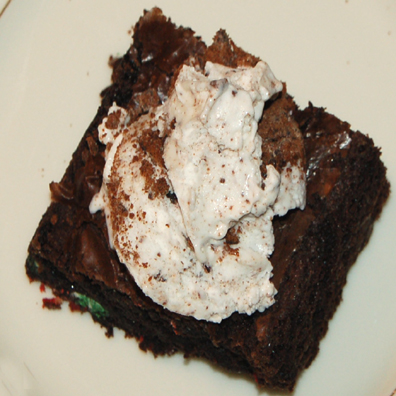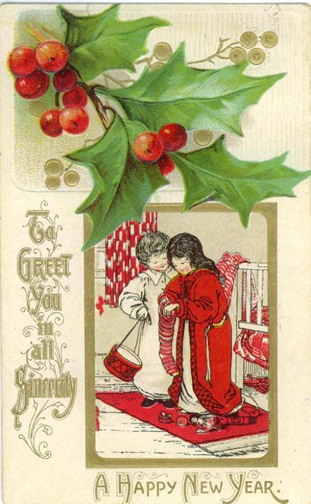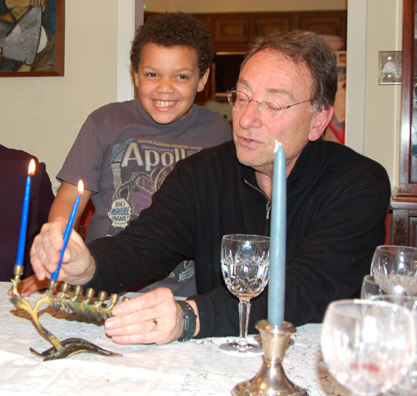
A few years ago I taught a recipe-writing workshop during reunion weekend at my college, Mount Holyoke. The participants worked during the workshop on linking memories to recipes. After the workshop ended, they were all supposed to e-mail me their finished recipes so that I could share them with the whole group.
The weekend (and life!) got busy, and hardly anyone sent in the recipes. One exception to this rule was Mary McDowell of the Class of 1971. (Mary, I hope you don’t mind my giving away your graduation year!) I fell in love with her brisket recipe, possibly the easiest dish I’ve ever made! Chop onions, pour some stuff into a pan, and you’re done.
Of course, I tinkered with it a bit. I do have trouble making recipes without tinkering. Mary bakes her brisket, covered, in a 250-degree oven for 8 to 10 hours (or more!). My sister-in-law Leigh and I were anxious to try out the All-Clad slow cooker, and the brisket seemed an ideal recipe for that pot. It was! We also cut back on the recipe. Mary originally called for a 10-pound cut of meat, but we have a small family. We used the full amount of beer and barbecue sauce she called for, although we might cut back on those a bit in future; the brisket was strongly flavored!
Mary wrote that this dish is a Christmas Eve tradition for her family. She caps it off with brownies topped with peppermint-stick ice cream, hot fudge, and crushed peppermint. We stopped after the ice cream, but the brownies à la mode did make an ideal (and snappy) finish. Add some noodles and a little green salad or vegetable, and the meal is just the thing for busy cooks who are tired from shopping, baking, partying, wrapping presents, and trying to be extra good for Santa!
I know I’m posting this too late for readers to prepare my menu on Christmas. I recommend it for New Year’s Eve as well, however. The tangy brisket and extra chocolaty brownies will keep you warm and start your year off deliciously.
Merry Christmas!

Mary’s Cousin’s Overnight Brisket (Adapted by Tinky and Leigh)
Ingredients:
1 3-pound slab beef brisket
2 onions, sliced into rings
12 ounces beer
12 ounces high-quality barbecue sauce
1 pound carrots, cleaned and sliced in half
Instructions:
The evening before you wish to eat the brisket, place it in the bottom of a slow cooker. Throw the onions on top, and top with the beer and barbecue sauce. Cook on the low setting overnight.
The next morning, stir the carrots into the stew. Continue to cook all day, still on low. Two hours before you want to eat, turn the heat up to high. Serve with noodles.
Serves 6 to 8.

Fabulous Fudgy Brownies (Adapted from King Arthur Flour)
Ingredients:
1 cup (2 sticks) sweet butter
2 cups sugar
2/3 cup Dutch-process cocoa
1 teaspoon salt
1 teaspoon baking powder
1 tablespoon vanilla
4 eggs
1 -1/2 cups flour
12 ounces (2 cups) chocolate chips
Instructions:
Preheat the oven to 350 degrees. Line a 9-by-13-inch pan with foil, and grease the foil.
In a good-sized saucepan over low heat, melt the butter. (The saucepan should be big enough so that it can double as your mixing bowl.) Add the sugar, and stir to combine. Return the mixture to the heat briefly—until hot but not bubbling. (It will become shiny looking as you stir it.) Remove it from the heat, and let it cool briefly while you assemble the other ingredients.
Stir in the cocoa, salt, baking powder, and vanilla. Add the eggs, beating until smooth; then add the flour and chocolate, beating well until combined. Spoon the batter into your pan.
Bake for 28 to 30 minutes, until a toothpick inserted into the center comes out dry (it may have a few crumbs). Remove them from the oven. After 5 to 10 minutes, loosen the edges of the foil. Cool completely before cutting and serving.
Makes about 2 dozen brownies, depending on how large you cut them.

- Michael REALLY likes these brownies!






















